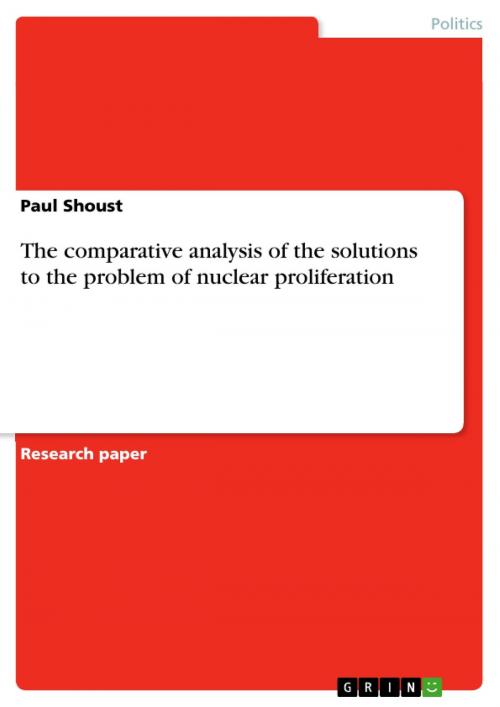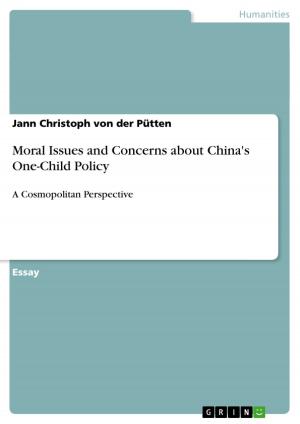The comparative analysis of the solutions to the problem of nuclear proliferation
Nonfiction, Social & Cultural Studies, Political Science, International, International Security| Author: | Paul Shoust | ISBN: | 9783640771509 |
| Publisher: | GRIN Publishing | Publication: | December 7, 2010 |
| Imprint: | GRIN Publishing | Language: | English |
| Author: | Paul Shoust |
| ISBN: | 9783640771509 |
| Publisher: | GRIN Publishing |
| Publication: | December 7, 2010 |
| Imprint: | GRIN Publishing |
| Language: | English |
Research Paper (undergraduate) from the year 2010 in the subject Politics - International Politics - Topic: Peace and Conflict Studies, Security, grade: Good, European University at St. Petersburg, course: Security and Disarmament in Europe, language: English, abstract: The world has not become safer in the 21st century. But there is only limited number of really global threats. Those include, inter alia, international terrorism, climate change, and the issue of nuclear proliferation. In its Resolution on the Convention on the Prohibition of Use of Nuclear Weapons, the UN General Assembly underlined that 'the use of nuclear weapons poses the most serious threat to the survival of mankind' . But despite a nearly universal recognition of the threat posed by the mere existence of the nuclear arsenals, the issue of further nuclear proliferation among the members of the international community is yet to be solved. In this paper, we attempt to conduct a comparative analysis of possible approaches to the issue of nuclear proliferation. The goal of the research, however, is not the elaboration of practical solution of the issue. We will focus on the conceptual value of the one or another option, instead. The aim is to define main dimensions of the problem that can be faced by the international community: be it in the universal fora (e.g., the UN General Assembly) or in the 'exclusive clubs' (the UN Security Council). First part will be dedicated to the theoretical approaches that may be employed in the research. Also, the framework for the comparative analysis per se will be defined. In the second part of the paper, we will focus on the determination of factors that should be taken into account during the comparative evaluation of the solutions. In the third part, the set of factors will be applied to the potential solutions; and we will try to define common and specific characteristics of every option. There are a lot of competent research papers dedicated to the problem of nuclear proliferation. Many of them were published before the end of the Cold War and, therefore, provide us with the dynamic view on the issue. Most of the literature used in the paper is dedicated to the problem of the theoretical and legal dimensions of the nuclear proliferation. A number of international documents were used as well: the Nonproliferation Treaty, the UN General Assembly Resolutions, etc. Mass-media sources proved to be a rich source of information. Additional information was derived from the statistical data publications, caselaw of the International Court.
Research Paper (undergraduate) from the year 2010 in the subject Politics - International Politics - Topic: Peace and Conflict Studies, Security, grade: Good, European University at St. Petersburg, course: Security and Disarmament in Europe, language: English, abstract: The world has not become safer in the 21st century. But there is only limited number of really global threats. Those include, inter alia, international terrorism, climate change, and the issue of nuclear proliferation. In its Resolution on the Convention on the Prohibition of Use of Nuclear Weapons, the UN General Assembly underlined that 'the use of nuclear weapons poses the most serious threat to the survival of mankind' . But despite a nearly universal recognition of the threat posed by the mere existence of the nuclear arsenals, the issue of further nuclear proliferation among the members of the international community is yet to be solved. In this paper, we attempt to conduct a comparative analysis of possible approaches to the issue of nuclear proliferation. The goal of the research, however, is not the elaboration of practical solution of the issue. We will focus on the conceptual value of the one or another option, instead. The aim is to define main dimensions of the problem that can be faced by the international community: be it in the universal fora (e.g., the UN General Assembly) or in the 'exclusive clubs' (the UN Security Council). First part will be dedicated to the theoretical approaches that may be employed in the research. Also, the framework for the comparative analysis per se will be defined. In the second part of the paper, we will focus on the determination of factors that should be taken into account during the comparative evaluation of the solutions. In the third part, the set of factors will be applied to the potential solutions; and we will try to define common and specific characteristics of every option. There are a lot of competent research papers dedicated to the problem of nuclear proliferation. Many of them were published before the end of the Cold War and, therefore, provide us with the dynamic view on the issue. Most of the literature used in the paper is dedicated to the problem of the theoretical and legal dimensions of the nuclear proliferation. A number of international documents were used as well: the Nonproliferation Treaty, the UN General Assembly Resolutions, etc. Mass-media sources proved to be a rich source of information. Additional information was derived from the statistical data publications, caselaw of the International Court.















